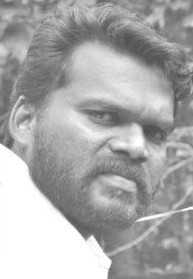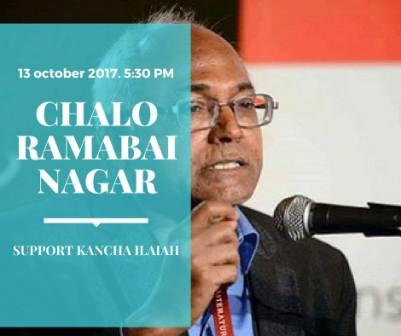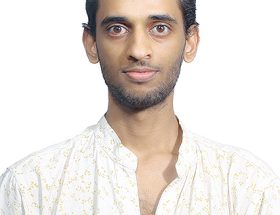C K Premkumar
[Tanslation of Malayalam article published in March 2016 edition of Onnippu Print Magazine. Translation done by Athmaja A B.]

“P S Banerjee and Mathayi Sunil bagged the Kerala government’s folklore awards this year. They are being introduced to the readers by their friend, through this article”.
It was the time when C K Janu was leading the Kudil Ketti Samarm (protest by constructing huts) in front of the secretariat against the A K Antony government. In between the protest calls, they used to sing their hearts out, like a ritual which used to cut through the city noise. A dark, skinny boy from the fine arts college nearby, used to come by and take part in the performance of those songs. He danced with them, rendering the protest spaces lively. At last, when the protest succeeded, he sang and danced in joy with the other protesters and became a remarkable visual for the newspapers and channels at that time. He is P S Banerjee, who secured the young folklore artiste award by folklore academy

The history of Banerjee’s musical life begins with his Pre degree studies at D B College, Sasthamkotta. It is someone else’s history too. It belongs to Mathai Sunil as well, who bagged the young folklore artiste award by folklore academy, along with Banerjee.
The greatest number of Dalit college students in Kollam district go to D B College, Sasthamkotta. Hence there was abundance in terms of arts in the college. Art forms such as theatre, folklore songs, street theatre ruled in that college. It is in such a place that Banerjee arrived. He also had the company of Prakash Kuttan, a degree student. Soon, the time of songs, dancing and performances followed. Works such as Aramanavattan, Kurathi, Mottasamrajyam and Nayjanmam were conceived. Thus, during the degree time, the painter and singer in Banerjee found immense growth.
When Banerjee joined the college for degree, the folklore songs had gotten a resurrection in the public. The society accepted folklore songs as a legitimate genre of performative literature. It is in this situation that the duo of Banerjee and Mathayi formed in Shasthamkotta college. Mathayi reached after Banerjee and soon found his own space in the college. After that, they were writing music history which cannot be erased. There is one collective which is to remembered when one follows these artists’ musical trajectory. The Nadodi performing group in the leadership of Prakash Kuttan, an incredible artist. The Dalit intellectual collective based out of Bharanikkavu, Shasthamkotta led to the formation of the performing group. They used to organize art processions in colonies in Kollam to promote Dalit ideas. These processions included street theatre, folklore songs and indigenous songs. Prakash Kuttan was one of the organizers of such performances. It is this way that Banerjee entered public stages. The members of these processions became ‘Nadodi’ later.

In the initial days, Nadodi performed short dramas and street theatre but later on moved to folklore songs when they were inspired by the songs of Dynamic Action(A people’s movement and Magazine from Thiruvalla,Kerala). Soon Banerjee and Mathayi became singers of Nadodi group. Gradually. It developed into a popular folklore song group.
Banerjee and Mathayi started out by performing songs sung by prominent artist C J Kuttappan but later, ventured out to explore the songs of the past. The songs they found are far too many to count. The Parvalli Kalippattu which starts with ‘ Ividuthe valiyamma..’, Kochikkarathi, Kadappurathe Karimanalil and Akkanam Munduthe are a few of those.

The group which started out by singing and using instruments such as Chenda and Kaimani, gradually grew to be very popular. Banerjee and Mathayi performed with Nadodi in the streets, festival grounds and for celebrations in the southern districts of Kerala. The team leader Prakash Kuttan’s support, dedication and attitude played a huge role in it. When the program performed for department of tourism was telecasted on Doordarshan, Banerjee and Mathayi became very familiar to folk song lovers.
Banerjee first sang with C J Kuttappan on stage during the felicitation ceremony given to Adivasi leader C K Janu in Punnamoodu, Sasthamkotta. Since then, Banerjee joined Kuttappan’s group ‘Thayillam’ as a singer. Mathayi also joined after a while. That’s how ‘Thiruvalla Thayilam’ became the stage for these three talented men. Thayillam helped Banerjee and Mathayi’s songs to reach more people. They travelled to various states in India with Kuttappan and performed songs. Later, Banerjee and Mathayi left Thayillam to focus on their own performing group, Kanal Pattukoottam. Even though, Mathayi continued to collaborate with Thayillam on intervals. Thayillam played a pivotal role in shaping the singers in Banerjee and Mathayi. They considered the songs as a means of coming together and happiness at first but after joining Thayillam, started to take the songs seriously. They got the strength to discover old songs and reinvent them from Thayillam. Many songs were learned from elders of Pandanadu, Kallada and Panthalam. They performed new songs at each performance of Thayillam. That could be the reason for these two’s reputation of being the best disciples of Kuttappan even though many has sang with Thayillam.
It was through Kuttappan that these two talented youngsters debuted in playback singing. The song “Ambum Kombum” from Pazhashi Raja (M T Vasudevan Nair and Hariharan), which was composed by Ilayaraja was sung by Kuttappan, Banerjee and Mathayi.
Their intervention also demolished the common notion that folk sings need only to sing. Their social life was not separate from their life of songs. They were in the forefront of protest to safeguard back waters and also for street theatre and art processions. They showed solidarity by their presence and performance to the protest staged by Gotra Maha Sabha in front of the secretariate.
When marginalized people try to reclaim their identity through their own indigenous art forms, the savarna state will always try to vanquish and resist that. They are incapable of being fearless of folk art. The fire of protest inherent in those art is the reason of their fear. An example of this is the arrest and imprisonment of folk singer Kovan in Tamil Nadu. These two men were at the forefront of gatherings, protesting Kovan’s arrest. Banerjee took part in the protest in Thrissur while Mathayi was at Sasthamkotta.

They were bothered greatly when folk art is mocked in the public. I am reminded of an experience from our degree days. A youth camp was organized by Mathrubhumi in Kollam. Nadodi was invited to perform there. The camp was quite active with singing and dancing. Poet D Vinayachandran was also there. The folk art ‘Thumbi Thullal’ was being performed. The women moved according to the organic rhythm. We were lost in the performance. But soon, the viewers started to comment inappropriately, passing vulgar comments such as “thumbi, kinnarathumbi”.(Reference to a movie) This disturbed the women performers as well as the Nadodi group members. The poet kept enjoying the show with the men. When it became unbearable. Banerjee shouted, “stop”. Soon, Prakash Kuttan and Mathayi said that our art is not meant to be viewed with vulgarity in mind. Because of their apt response, the Thumbi Thullal team also declared that they will never perform in front of them again. During that time, the poet remained without any response. That day, we realized that only we will be able safeguard our art and folk rhythms. For others, it is mere entertainment.
Banerjee is handling the life of a painter along with that of a musician. He has done illustrations for books such as ‘Kuttante swargam’ (Muhamma Ramanan), Kuzhiyana( Muthapuram Mohandas), Kilikunju (A V Vijayan), ‘Kizhavanum kadalum’ ( Ramakrishnan Kumaranelloor), ‘Tikkooro’ ( Dr. P K Bhagyalakshmi), ‘School Kathakal’ (N Krishna Das), manthrika katha (afis muhammed) and so o. Banerjee has drawn may cariatures of renouned personalities. The Buddha statue which is going to intituted at Budhapoornima in Pathanamthitta by DHRM is sculpted by Banerjee. The sculpture is created, following a Dalit perspective. Banerjee has performed songs in many gulf countries. Currently, he is working as a pre-production artist with Lumicell technologies, Technopark.
The paths of folklore music took Mathayi Sunil to the world of film music. He entered those spaces which were reserved for those with only classical training. Mathayi started out by singing chorus in the film Pazhashi Raja, the music was composed by Ilaya Raja. Now he is a well-known playback singer. He has sung songs for movies such as Iyyobinte Pusthakam, bachelor party, Mullamottum Munthiri harum, celebration and oru murrai vanth pathaya.

These young talents have a two decade long, rich musical life to their credit. Its not a mere coincidence that these two got the award together, in the same year after, studying in the same college and being part of the same musical collective. Today, both Banerjee and Mathayi are very active in singing through Kanal pattukoottam (Shasthamkotta) and Pattupura respectively, carrying on the indigenous tradition, with organic rhythms of the life’s truths.
P S Banerjee
Born in Manayil house, Manakkara, Shasthamkotta, to V Pachu and Subhadra., Banerjee’s siblings are Azad and Chatterjee. Sreeprabha is his partner and they have a son together, Oscar banerjee. He studied in JMHS Shasthamkotta, D B College, Shasthamkotta and Fine arts college, Thiruvananthapuram. Banerjee is well versed in illustration, sculpture, caricature and animation. He has taken part in singing for CD collections such as Kanal, Mitharam. Theyyarayyam, and Kuruthola. He is currently working as a pre-production artist with Lumicell technologies, Technopark, Thiruvananthapuram.
Mathai Sunil
Mathayi was born in Idayilappura house near peruviruthi Malanada temple Kollam to Ammanan and ponnamma. He studied in GUPS Idaykkadu, Jayajyoti HS Shasthamnada and D B College, Shasthamkotta , he is very active in folklore singing and playback singing. He has performed in countries such as Bahrain, Qatar and USA. Now, he works as a singer with Pattupura, Shasthamkotta.
~~~










